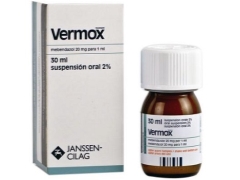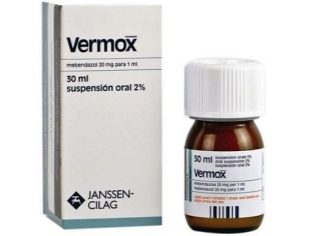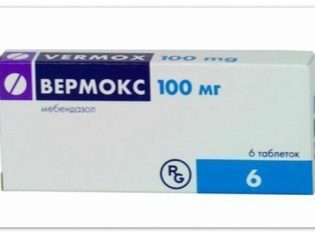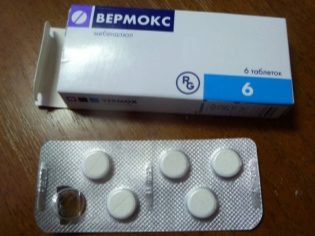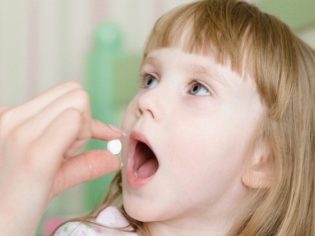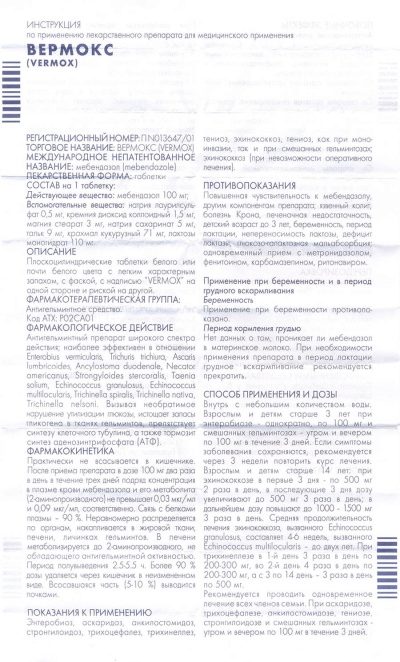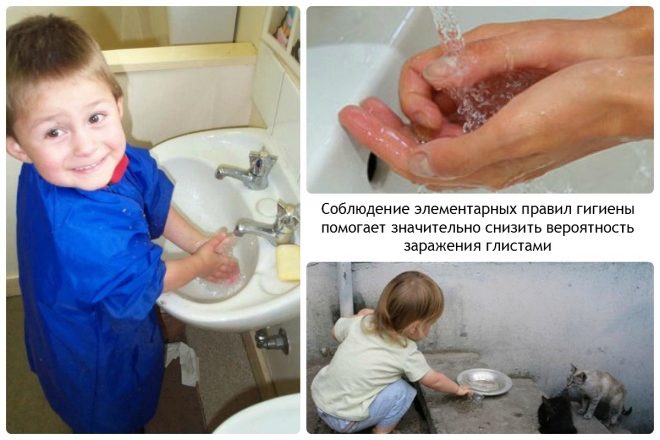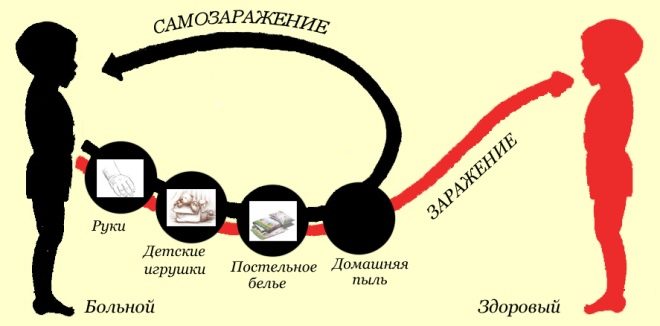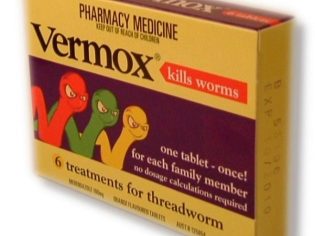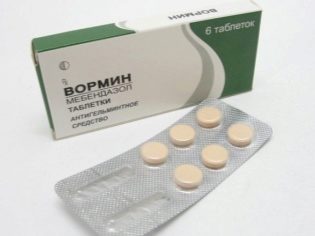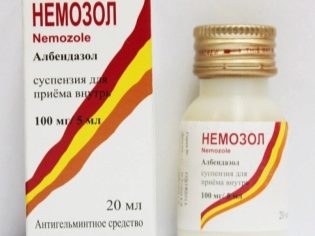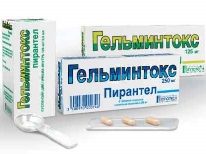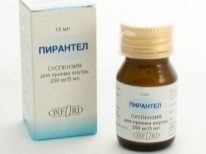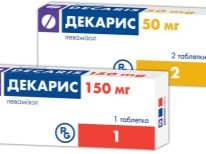"Vermox" for children: instructions for use
To get rid of worms in the children's body requires the appointment of effective antihelminthic drugs. Is Vermox such a remedy, under which helminthiasis it helps, how it is dosed for children and what side effects can it provoke?
Release form
Vermox is produced by Gedeon Richter in tablet form, 6 pieces in one pack. The medicine is represented by flat-white white tablets, which have a slight characteristic odor. One side of these pills contains the inscription Vermox, and the other - at risk, according to which the medicine can be divided into halves. The manufacturer does not offer any other forms of this medication, for example, syrup or suspension.
Composition
The main component of the drug, due to which the tablets have an anthelmintic effect, is represented by mebendazole. Each tablet contains 100 mg of this substance, supplemented with talc, lactose, colloidal silicon dioxide and corn starch. Also included are magnesium stearate, sodium lauryl sulfate and saccharin.
Operating principle
Mebendazole has extensive antihelminthic effects. The compound affects the metabolic processes in the tissues of parasites, which leads to their death. The drug is especially effective when infected with pinworms (they are the causative agents of enterobiosis) and whipworm (this worm causes trichocephalosis). It also acts on:
- ascaris;
- intestinal blackheads;
- pork tapeworms and their larvae;
- American necators;
- echinococcus;
- hookworm;
- trichinella and other parasites.
The tablets, once in the intestine, are almost not absorbed and, to a greater extent, are excreted unchanged with feces. The part of the drug that is absorbed, binds to proteins and is carried by blood to the liver and adipose tissue. Also, the drug accumulates in the larvae of worms. Kidneys are involved in the removal of absorbed mebendazole.
Indications
The drug is required for:
- trichocephalosis;
- enterobiasis;
- strongyloidiasis;
- ascariasis;
- eynococcosis;
- hookworm;
- trichinosis;
- multiple nematodes;
- capillariasis;
- alveococcosis;
- tenioze;
- gnastomosis;
- infection with several types of worms.
At what age is it allowed to take?
The medication is prescribed for children over 3 years old. Giving it to babies in the first two years of life is dangerous because of the risk of seizures. Prescription medication in this age group is possible if the doctor has identified a serious worm infestation that interferes with the physical development and digestion of the crumbs. In this case, the dosage and treatment regimen is determined individually.
Contraindications
The use of drugs is not recommended:
- children who are hypersensitive to mebendazole or another component of tablets, for example, to lactose;
- young patients with Crohn's disease or ulcerative colitis, because the drug can cause blockage of intestinal lumen with worms, which will worsen the child's condition
- a child with liver failure, since the drug has properties that adversely affect the functioning of the liver.
Side effects
The most common adverse reactions of the digestive tract and nervous system. Children's bodies may react to Vermox with nausea, dizziness, or abdominal pain.If the drug is taken for a long time in large doses, it can lead to allergic reactions, headaches, diarrhea, vomiting, caused by the death of worms and a large number of toxins in the bloodstream.
In addition, the drug causes an increased load on the liver, so under the influence of mebendazole in young patients, the activity of liver enzymes may increase and the level of creatinine may increase.
The long-term treatment with mebendazole also has a negative effect on blood formation. In the blood test, reduced leukocytes, enlarged eosinophils, and symptoms of anemia can be detected. Urinalysis can show cylindruria and hematuria.
Instructions for use and dosage
- The tablet should be drunk after a meal, washed down with a small amount of water. It can both be swallowed and chewed. If the child is small, the drug is permissible to crush and mix with water.
- When pinworms infect a child of 3-10 years old, they give 1 / 4-1 / 2 tablets, and at the age of 10 years old - a whole tablet. In this dose, the medicine is taken 1 time. If there is a high risk of re-infection, after 2-4 weeks it is recommended to repeat the reception in the same dosage. In addition, it is important to treat other family members who live with the child in the same house.
- If ascariasis, teniasis, trichocephalosis, strongyloidosis, hookworm or mixed helminthiasis are found in a child, the drug should be taken for 3 days. The child is given 1 tablet in the morning and in the evening (only 2 tablets per day).
- Trichinosis in a small patient requires the use of higher doses. The first three days give 2-4 tablets per reception, and from the fourth to the tenth day - 4-5 tablets per reception. The medicine must be taken three times.
- High dosage and a special treatment regimen is also needed for echinococcosis. The child is given 5 tablets per reception. First, three days they need to be taken twice a day, and then for another 3 days, go to a threefold intake. After that, the dose is increased (it is calculated by weight) and divided into 3-4 doses.
- After completion of treatment, the child should be examined (hand over feces or smear). If during the week after therapy, neither the worms nor their eggs are found, the treatment carried out is considered effective.
And now Doctor Komarovsky will tell us how to find out if the child has worms and what kind of prevention is needed.
Overdose
Too high dose of medication, taken once, becomes a cause of violations of the digestive tract. The child has severe abdominal pain, severe nausea, loose stools, an attack of vomiting. For treatment, the drug is removed from the stomach (washed, cause vomiting), and then give sorbents.
If an overdose of the drug occurs over a long period, it adversely affects the liver and can provoke hepatitis. In addition, the child develops neutropenia. Such changes cause the need to control the analysis of blood and urine, as well as liver function, if the anthelmintic agent was prescribed a long course.
Interaction with other drugs
- Vermox is not recommended for use with any lipophilic compounds, for example, with metoprolol.
- The drug is not prescribed together with drugs such as phenytoin, ritonavir and metronidazole.
- When taken simultaneously with carbamazepine, the concentration of Vermoxa in the blood decreases, and during treatment with cimetidine it increases.
- During treatment and during the day after its completion, the child should not be given laxative medications or fatty foods.
Terms of sale
To buy pills at the pharmacy you need to get a prescription from a doctor. The average price of a package of 6 tablets is 90 rubles.
And now the full editions of Doctor Komarovsky about worms in children.
Storage conditions and shelf life
Store tablets at home is recommended at a temperature of 15 to 30 degrees Celsius. The preparation should lie in a dry place where a small child cannot find it.The shelf life of the drug is quite long and is 5 years from the date of issue.
Reviews
Mothers who gave Vermox to their children with helminthic invasion, in most cases, are satisfied with this treatment. They like the efficacy of the drug, a wide range of effects on different worms, convenient packaging and low cost. Among the minuses are called the toxicity of mebendazole, due to which some children have negative side symptoms.
Reviews of parasitologists confirm the very high efficacy of the drug for pinworms. Only one tablet in most cases helps to get rid of such small parasites and the resulting digestive disorders, as well as itching in the anus.
Many parents choose this drug for the prevention of infection with parasites, since it is enough to take only 1 tablet for prophylactic purposes. However, doctors do not recommend such actions, since most pediatricians believe that worms should be treated only when they are detected.
Analogs
If for some reason you cannot treat the child with Vermox, you can replace the drug with one of these medicines.
- Pills Vormin. The effect of this anthelmintic agent is also due to mebendazole. It is prescribed from 3 years of age.
- Pills Dekaris. This medicine, in two dosages, contains levamisole. It is also produced by Gedeon Richter. The drug is contraindicated up to 3 years, and three-year-old children and older children can only be given tablets with 50 mg of levamisole.
- Drug Nemozol. It comes in several forms - chewable tablets, suspension, coated tablets. The basis of this medicine is albendazole, effective against Giardia, Echinococcus, Ascaris, Trichinella and other parasites. Doctors prescribe Nemozol at any age, if there are grounds for this and the babies have no contraindications.
- Medication Pyrantel. Such a suspension is prescribed for enterobiasis, ascariasis and other worm infestations from 6 months of age. The drug is also available in solid form (250 mg tablets).
- Drug Helmintox. This medicine also contains pyrantel and is produced both in coated tablets and in suspension. It is used in the fight against ascaris, pinworms, or hookworm in children older than 6 months.
Determine that it is better to replace "Vermox" in the treatment of a specific helminthiasis, should the doctor. For this reason, you should not give any antihelmintic drug on your own or change the drug to a child.
